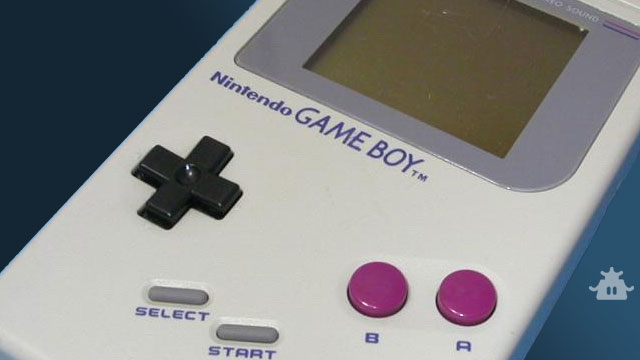
If imitation is the sincerest form of flattery, color Game Boy’s cheeks pink and blustery. After Game Boy rewrote the book on portable gaming, Nintendo’s competitors all believed one thing with absolute conviction: they could make a better handheld. Though the average consumer had no problem with Game Boy’s colorless graphics and unlit screen, companies like Sega and Atari were convinced that if a handheld touting those absent features came along, it would blow Nintendo out of the water. One by one, for many years, companies produced handhelds dubbed Game Boy “killers” for resale, and one by one, they failed. Let’s take a peek at Game Boy’s would-be slayers!
Atari Lynx
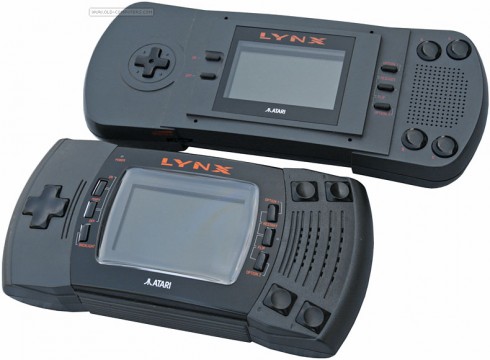
Released: 1989
Arriving very soon after Game Boy’s launch, Atari’s Lynx tried to dethrone Nintendo’s handheld before it had even gotten comfortable in its throne. Featuring the first full-colored LCD screen and 16-bit processor to ever grace a portable video game console, Lynx was lightyears ahead of what Game Boy was offering, indeed, almost frighteningly so. Its graphics were gorgeous, and Lynx’s brilliant lit screen only served to highlight those visuals even more. Armed with an adaptable button layout that was accessible to both right and left-handed players, Atari (who hadn’t all that long ago botched its chances to sell NES in America) believed its innovative machine would get the company back into the public’s consciousness.
When players got their hands on Lynx, which sold through its initial orders easily enough, the cracks began to appear. Lynx’s game cartridges were difficult to remove from the system, for starters, which forced Atari to redesign their casings. The games themselves, meanwhile, left much to be desired, as Lynx had no true showpiece to lure players like Nintendo did with Tetris on Game Boy. Worst of all, though, was the handheld’s atrocious battery life. Lynx required six AA batteries to operate, and would blast through them in around four to five hours. Without someone like Game Boy creator Gunpei Yokoi on staff to temper Atari’s desires with reality, Lynx was released as a remorseless battery hog, and players were left dissatisfied. An AC adaptor took some of the sting away, but dependance on its use essentially ruined Lynx as a portable system. Atari would continue to try and push the device, most notably redesigning it as the smaller, more affordable Lynx II in 1991, but it was too little, too late.
NEC TurboExpress
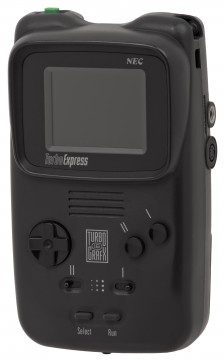
Released: 1990
NEC’s TurboGrafx-16 was the first 16-bit home console, co-developed with Hudson Soft. Hudson had attempted (much like Philips and Sony later would try) to join with Nintendo to create a more advanced gaming console, but when the venture didn’t materialize, turned to NEC with its rejected technology. While TurboGrafx would go on to combat Genesis and eventually SNES, TurboExpress was NEC’s trooper on the portable front. Able to play all TurboGrafx TurboChips (the name for NEC’s credit card-shaped game cartridges), TurboExpress came touting cutting edge graphics, a glowing screen, and the same problems as Lynx, plus some of its own.
TurboExpress was notorious for its numerous malfunctions. TurboExpress’s screen was susceptible to dead pixels and its audio flickering out, sometimes rendering the device unplayable. Further compounding the issue was the console’s poor screen resolution. With the majority of titles designed to be played on a TV, the comparatively diminutive screen of TurboExpress would display text in some titles illegibly. As with the Lynx (and nearly every other Game Boy opponent to come in the next few years), TurboExpress couldn’t be played for more than three hours or so on six AA batteries. Being a power glutton prone to hardware failures crippled TurboExpress, which never ate into a noticeable amount of Nintendo’s market share.
Sega Game Gear
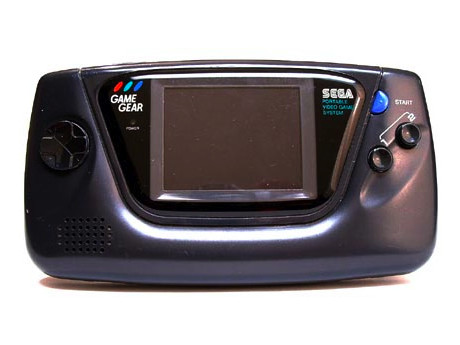
Released: 1991
Sega and Nintendo’s rivalry during the early to mid nineties is the stuff of legends when it came to SNES versus Genesis. Game Boy versus Game Gear, however, was a much more lopsided altercation. Like Lynx, Game Gear went straight for Game Boy’s throat by countering its two seemingly most damning deficiencies; monochrome graphics and a screen without light. Though not as technologically robust as Atari’s or NEC’s handhelds, Game Gear still boasted a bright, vivid display with graphics on par with Sega Master System (the company’s answer to NES), and appeared ready to send Nintendo to the end of the line and back to the drawing board. As Sega prepared for what it surely believed was going to be a real slaughter, Yokoi’s insistence on long battery life had also fallen on deaf ears within the halls of Nintendo’s nemesis.
Six AA batteries powered Sega’s portable, with a run time of roughly three to four hours. Compare that to Game Boy’s economical nearly thirty hours of run time off of four AA batteries, and it becomes clear how huge Sega’s blunder was. While Game Gear was already being sold for $60 more than Game Boy at $150, factor in the cost of replacing batteries constantly and it’s pretty obvious why so many people chose Nintendo’s portable. There was the option of using an AC adapter to extend playtime, but as with Lynx and TurboExpress, being tethered to an outlet severely hampered the “portability” aspect of owning a handheld rather than a home console. Being big, power-hungry, and expensive all tipped fortune from Sega’s to Nintendo’s favor. Though the title had some solid titles to brag about, it wasn’t enough to court fans or third party developers, and Game Gear remained a very distant second over the course of its lifespan.
Sega Nomad
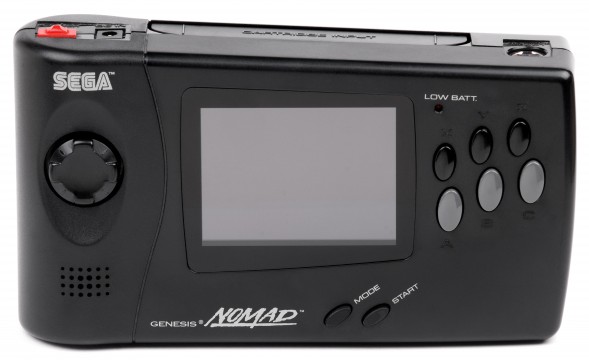
Released: 1995
Nearing the middle and end of the SNES versus Genesis console war, Sega created a number of peripherals to bolster its aging home system. Devices like Sega CD (which introduced a CD drive that played disc-based games on Genesis) and 32X (another add-on that plugged into Genesis and offered 32-bit gaming experiences on cartridges) attempted to draw in new players by bridging the gap between Genesis and Sega’s next system, Saturn. In a similar attempt to rejuvenate its floundering handheld division, Sega developed a portable version of Genesis which could play that console’s library of games on the go. That system’s name was Nomad. Released exclusively in the US, Nomad sported all the processing power of a Genesis in a handheld, playable on a bright, backlit screen.
While the idea of playing Genesis games outside of the home was surely invigorating to many, Nomad had issues. It goes without saying that all that power came at a terrible cost to battery life; the apparently requisite six AA batteries of power-mad handhelds that fueled a Nomad became empty husks after a measly two hours. Nomad also didn’t have its own game library, and instead relied on titles from Genesis (interestingly, Nomad could be tethered to a TV much like how Sony’s PSP would be able to, in the future). Strangely, Sega didn’t think to bundle Nomad with even a single title, perhaps assuming players would already have a collection of games to draw from, instead. With almost zero support from Sega, which was too busy preparing the launch of Saturn (for its own imminent failure, sadly), Nomad was dead on arrival.
SNK Neo Geo Pocket Color
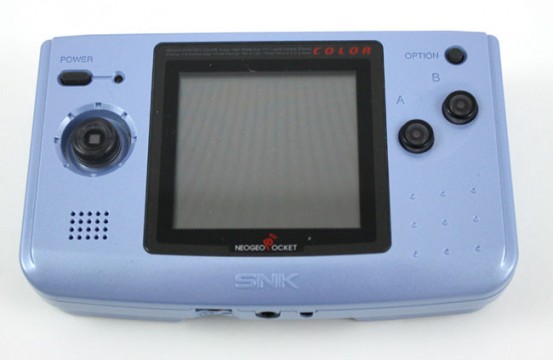
Released: 1999
As bizarre as it might seem, it took ten years for a video game company to come up with a truly competent opponent for Game Boy. The name of that company was SNK, which brought Neo Geo Pocket Color to the table. A year previous in Japan, SNK had made its first stab at Nintendo’s handheld with Neo Geo Pocket, which was essentially the same console, but without color (as the name suggests!). It was a mistake; Game Boy Color was a lion bursting through the gates at launch, and Neo Geo seemed like a step backwards compared to the new handheld. After just a year on the market, SNK immediately reworked its handheld to feature a colored screen and backwards compatibility with Neo Geo Pocket’s small library of games, and this time intended to sell the system internationally. Unlike Atari and Sega’s seemingly oblivious offerings, Neo Geo Pocket Color went the Yokoi route of being affordable, practical, and capable of playing great games. There was only one problem: the internet.
In 1999, the world was not the internet savvy place it is now. The average home wasn’t hooked into the world wide web, and it would be years before anyone outside of eBay, let alone an obscure video game company like SNK, would be able to turn a real profit selling things via computer. Sadly, SNK believed that enough people were online to warrant selling Neo Geo Pocket Color exclusively through web retailer eToys. Priced well under Game Boy Color’s asking at $70, and boasting a slightly superior quality of internal hardware and a sleek design, Neo Geo Pocket Color should have been a true competitor to Nintendo. It even had a crazy-good battery life of almost forty hours on two AAA batteries! The reality, though, was that the system didn’t reach many consumers through eToys, and when it finally did start to hit brick-and-mortar retailers, both fan and developer interest was squarely on Game Boy Color. Neo Geo Pocket Color does enjoy a respected, if meager games library, but SNK’s initial misfire irreversibly scuttled the system.
Nokia N-Gage
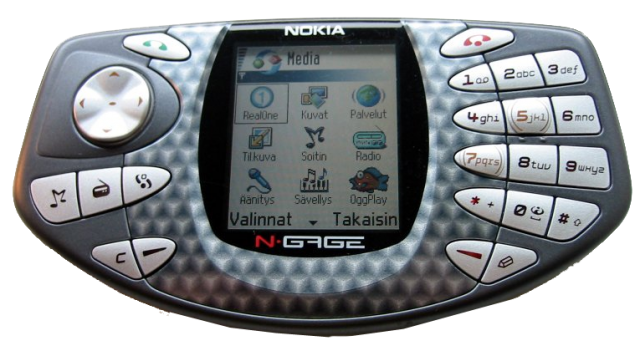
Released: 2003
Some will say Nokia’s N-Gage was a classic example of being in the right place at the wrong time, but the reality isn’t quite so rosy. Released right towards the end of Game Boy Advance’s lifecycle (and that of the Game Boy line, itself), N-Gage was billed as a hybrid cellphone/gaming handheld (amongst a myriad of other functions). The concept was really rather revolutionary on Nokia’s part, as the phone manufacturer believed it could offer in N-Gage a device that would alleviate the need for a separate gaming device and cellphone. N-Gage actually helped pioneer features that are commonplace in today’s smartphones and gaming consoles, like playing multiplayer games via bluetooth and the internet, but a number of flaws sent N-Gage packing quite quickly after launch.
The device itself was cumbersome to use. To make calls, users had to speak into microphones which were located on the sides of the phone, rather than on the face (or even the back!). To switch out game cards, the N-Gage’s battery pack had to first be removed, effectively requiring users to restart the phone every time they wanted to play a different game. The screen was also oriented in an odd vertical manor, as opposed to the more natural horizontal situation of Game Boy Advance’s screen. Again, Nokia was on to something with N-Gage, but it would be several years before technology could keep pace with what it envisioned. Game Boy Advance barely blinked as N-Gage stumbled out of the gates, and though Nokia redesigned N-Gage as N-Gage QD (which in fairness did address some of the original’s shortcomings), it wasn’t enough to earn back consumer trust. Nokia eventually relegated N-Gage to be a gaming service as opposed to a dedicated piece of hardware. As a whole, N-Gage was ultimately little more than a blip on the radar.
There are plenty of other handhelds that tried to make their mark. Gamate, Supervision, Game.com (it’s astonishing that Tiger waited so long to strike!), and WonderSwan (which was manufactured by Namco exclusively for Japan and was the last console Yokoi ever designed before his tragic death) all spring to mind, each with its own spin on Game Boy, and each falling short of such a lofty aspiration. In the end, Game Boy reigned over the handheld market not just by virtue of its competitors’ failings, but by its own unparalleled superiority. Nintendo did everything right with Game Boy, from its hardware design to its pricing, and the success the company saw was a direct result of how much the line resonated with players.




 ShareThis
ShareThis






